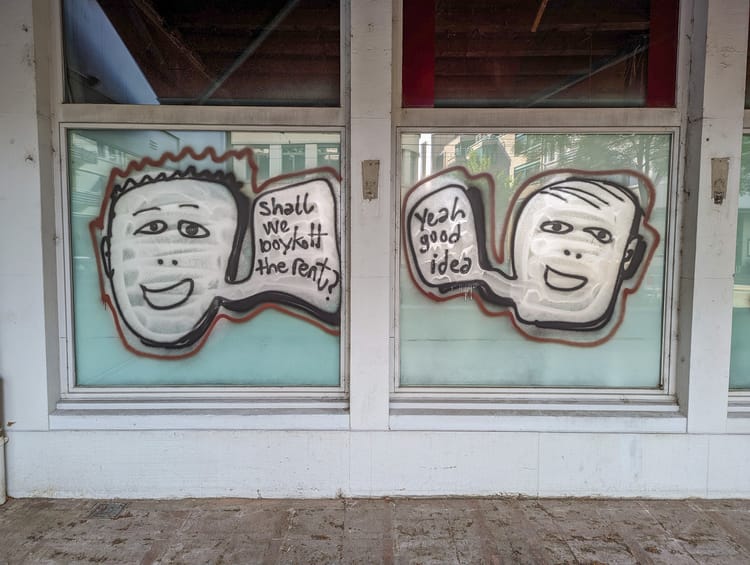Re-Imagining the CUSTOMER in Customer Service (by Stephen Faciszewski)

Greetings friends!
Klugne readers are smart. This is most apparent when you can see them in action yourself.
Today's illuminating Guest Post comes from my friend Stephen, who takes us on a journey to understanding and improving an aspect of life dear to us all: Customer Service.
Read along, and you may also come to some self-knowledge and improvement.
I expect few would argue against the premise that, historically, Western economies (particularly, the U.S.) were significantly more self-reliant (and U.S. society and its populace more self-sufficient), relative to our contemporary, globalized economy.[1]
We’ve all become more dependent on third parties to support the goods and services we consume.
Yet, it seems customer service outcomes, primarily focused on loyalty and customer retention, insufficiently cater to a global, dependent consumer.[2]
Customer service doesn't earn the name
From a strict customer viewpoint, customer service teams often seem to eschew meaningful problem-solving and productive outcomes in favor of:
- cost-reduction;
- purportedly, higher throughput; and,
- re-designed and consolidated business functions
none of which, per se, provide increased customer satisfaction, much less, access to increased knowledge or experience toward effective problem-solving in support of customer service.[3]
Apparently, contemporary support services have driven consumers seeking support toward ubiquitous, digitally platformed, self-help alternatives.[4] In reality, I wonder whether such woeful customer service outcomes have exacerbated unnecessary waste generation and business process inefficiencies.
Numerous factors contribute to the current state of affairs in the customer service industry, notably, an over-abundant supply of low-cost | low-quality, foreign-produced products, supplied by behemoth foreign manufacturing apparatuses that have little relationship with (or interest in providing customer support for) domestic consumers.[5]
Few would have predicted that President Nixon’s 1972 visit to China would have opened the door for such outcomes to emerge.[6]
In my experience, the level of customer service competency (roughly equated with acquired technical skill and in-depth, product-specific knowledge) remains inversely proportional to how large is an organization.
I long ago stopped tracking recurring (personal) incidences whereby, for example:
- technology platforms fatally failed to communicate, or, were missing one (or more) critical digital interface(s)…;
- an “important” electronic or mechanical ‘convenience’ gadget malfunctioned or stopped working and, per Murphy’s Law, often just beyond the end of a replacement or repair warranty period[7];
- a medical provider’s invoice (or any one of numerous other documents) corresponded to services that were improperly electronically coded leading to a corresponding healthcare insurer inappropriately denying the claimed benefit; or
- any other of innumerable reasons one might seek technical support or knowledgeable customer service expertise and assistance.
And, invariably (at least for the largest consumer-oriented corporate entities), the contemporary “customer service team” translates to “offshore”, often, a help center located 6,000 (or more) miles outside one’s originating location, and, not directly managed, but rather, overseen via an unaffiliated intermediary.[8]
Based on personal experience, such offshored models may well require those needing assistance to wait, on hold, for considerable periods, alternatively, either never receive a call-back, or, discover that a random resource on the other end of the line, despite being wholly well-intentioned, is inadequately-trained or under-experienced, merely reading scripted results from a monitor screen, much worse, reciting a “trouble-shooting” protocol identical to (or nearly so) a self-help search result. Should, a need for technical (or other) support force one to seek assistance via any of an organization’s various ‘chat’ channel(s), well, then, simply, ugh![9]
Within the context of these systemic customer service shortcomings, my interaction with support personnel tended to re-enforce less desirable character traits; that is, until I started re-imagining how I might more effectively interface with and utilize a customer service infrastructure over which I had negligible, if any, influence…
What inspires a person to reimagine customer service
By way of background, my parents raised my siblings and me within a ‘can-do’ experiential framework, specifically, that which prioritized resource conservation and up-cycle (or re-use) toward minimizing unnecessary household waste production.[10]
My parents’ formative experiences[11] directly informed the structured family system they fostered for my siblings and me. By my early teens, my mother had secured an employed role outside the home.
With both parents in full-time positions, to share household responsibilities, each family member was responsible for a subset of all household chores, e.g., mowing the lawn, doing the laundry, vacuuming, window washing and installing (in winter) or removing (in summer) storm windows (this was, by the way, in a pre-insulated glazing era), and the like.
Then, of course, there were those one-time, special household projects in which my teenage siblings and I participated: excavating, form-setting and pouring a concrete driveway, or, scraping, sanding, prepping and painting an exterior soffit, among countless other projects.
I don’t recall either of my parents e-v-e-r calling a plumber, electrician, mechanic, landscaper, accountant (or any other tradesperson for that matter). Neither our school work, extra-curricular sports, or youthful friendships suffered; and, by our mid-teens, my siblings and I each had part-time, employed roles (particularly during summer breaks from academic years).
Indeed, due specifically to these experiences, at a relatively early age, my siblings and I learned numerous invaluable, practical, and meaningful life skills.
Now, one might inquire, what does any of this have to do with modern-day customer service? Frankly, quite a lot.
In reflecting on these collective life experiences, on a much broader level, personal fulfillment directly correlates with how well we feel we’ve navigated life’s daily activities;[12] and self-sufficiency (not to mention the underlying psychological and emotional health it imparts)[13] is instrumental in traversing the inevitable challenges along one’s journey.
The meaning of success (professionally and personally, regardless of how one might define it), within the context of a broader support paradigm, has evolved for me to directly correlate with one’s (or, for that matter, an organization’s) ability to, foster another’s sense of being self-sufficient.[14]
Therefore, re-imagining customer service, in the broadest sense (and within the context of daily living), implies that each of us is, at once, both the customer and the support team (the SAG team).[15]
Certainly, no one would argue the truly positive, emotive sense one experiences when bearing witness to, and more importantly, somehow actively contributing to, another’s self-sufficiency.[16]
It’s easy (and, culturally favored[17]) in almost every facet of a shared modern existence, to vehemently call out and disparage copious short-comings, rather than actively participate in problem-solving.
Also coined an age of self-entitlement[18], which, at least in part, seems to underlie some of what plays out in a hyper-polarized national (and trans-global) discourse (itself, which has spawned an apparent crisis in civility and cooperative outcomes),[19] a more relevant question[20] might have us ponder:
How might I alter an entitlement mindset toward depending less on external resources in favor of building (or re-building, as the case may be…) self-knowledge and skill development, whether, for myself, or, arguably, more importantly, for another?
As well, borrowing Greenleaf’s leader-as-servant theory, might we all relate, one to another, not merely as parties in an arms-length transaction, but rather, as one sincerely interested in supporting better, collective outcomes.[21]
Personally, responding thoughtfully to this query has been instrumental in tempering my resentment of (and, regrettably, sometimes expressed disdain for) external service and support structures that seem to represent everything but ‘good’ (much less, mere adequate) customer support, whether in the first instance or after-the-fact.
Guidelines for Effective Customer Service Interactions
In that spirit, I found it useful to capture the following guidelines for more effectively interfacing with structures over which most of us have very little influence:
- View yourself as your own best problem-resolution resource. Don't be misled to believe anyone else cares more than you do about fixing (much less, even has an interest in…) your issues.
- In the age of all-things-Internet, undertake to acquire at least a basic understanding of facts and circumstances giving rise to an issue. Consider treating any customer support exercise as a learning experience, rather than a dreaded task. Indeed, as I sometimes discover, ‘tooling-up,’ so to speak, may resolve one’s underlying problem in the first instance.
- Get organized. Gather all relevant documentation (installation instructions; user’s | owner’s manuals; receipts; correspondence history; etc.), and, at least, be familiar with its substance and content. Most well-run organizations maintain websites that provide downloadable (if not printable) access to information.
- Simplify your ask for support. Distill your support issues into as few elements as possible (sometimes, it’s useful to write them down in advance of reaching out to any support resource), and, though context-specific, be explicit in identifying what outcome you seek.
- Pursue dynamic and personally-interactive support channels, unless a good reason exists to do otherwise. In-person assistance or ‘live’ phone conversations are more likely to achieve better service outcomes (see Footnote 9); I avoid whenever possible any form of ‘chat’ (via online exchange, mobile texting, or any alternative variation). If written support is the only alternative, then, favor the e-mail channel over any other.
- Go directly to the source. Be resourceful in identifying support resources, and, reach out (unless either impossible or functionally impractical) to the entity that at least assembles (if not, preferably, designs and manufactures) an underlying product at issue;[22],
- With any third-party resource, above all be cordial. The idiom: “…one catches more flies with honey…” applies here. Vinegar and salt usually beget, in response, sour and brine.
- Develop skills in tenacity. If at first you don't succeed, don’t abandon your target outcome at the first roadblock. While many have developed basic skills in directly asking for assistance from a higher level of authority (e.g., “…Can I speak to a supervisor [alt., …with your manager]…”), if a first-response resource seems skill- (or authority-) deficient, I’ve discovered this tactic proves hit-or-miss.
Now, if I am engaged in a ‘live,’ interactive phone conversation absent a meaningful outcome, I often cordially thank whoever is the customer support resource and sever the connection. I either promptly re-dial (and, 99 times out of 100, another person answers…), or, if patience runs thin, I defer until a later time. It can take multiple attempts to resolve any particular issue. - Embrace disassembling a device or deconstructing a vexing problem. I appreciate many caveats apply here (not the least of which may be copious warnings of injury or harm…). Many either don’t have the requisite tools or don’t want to allocate effort and time toward this self-support alternative.
Yet, for the intrepid, there are often valuable skills and knowledge to be gained, not to mention that any resulting successful outcome in this vein invariably boosts one’s self-confidence (i.e., self-sufficiency), significantly so, in some instances. - When all else fails, apply Reinhold Niebuhr’s adage: ‘…accept things we cannot change…’ Sometimes, despite our best efforts, recognizing that the Cosmos intends another result is a psychologically and emotionally healthier outcome. If I ultimately give in, I try to use the experience as an opportunity to explore any relevant lessons learned and knowledge gained in the process.
In the case of premature product failure, as a last-ditch effort I generally first attempt unsupported DIY repair/resolution (#9, above). If that fails, to curtail unnecessarily contributing to excess global waste, I will disassemble to liked-grouped components (i.e., metals, glass, electronics (and conductors | wire), batteries, and, invariably, ubiquitous plastics) and recycle.
Writing this article led me to an outcome I never envisioned at the start. It allowed me to examine a common commercial business structure to which I was introduced early in my professional career,[23] as well as assess (internally and interpersonally) how I (and, we, more broadly), as participants in broader, global economic systems might more effectively interface with less-than-optimal customer support.
While several conceptual threads captured here may encourage your further independent research and attention,[24] I'm happy that readers might experience less challenging interactions with support personnel and systems.
If in the process we fortuitously augment individual (or, better yet, collective) self-reliance, well, that would be a cause to celebrate.
Be well.
Each week brings you lovely prospects for an engaging discussion, possibly even wisdom. Make sure to subscribe to the free weekly newsletter.






Member discussion